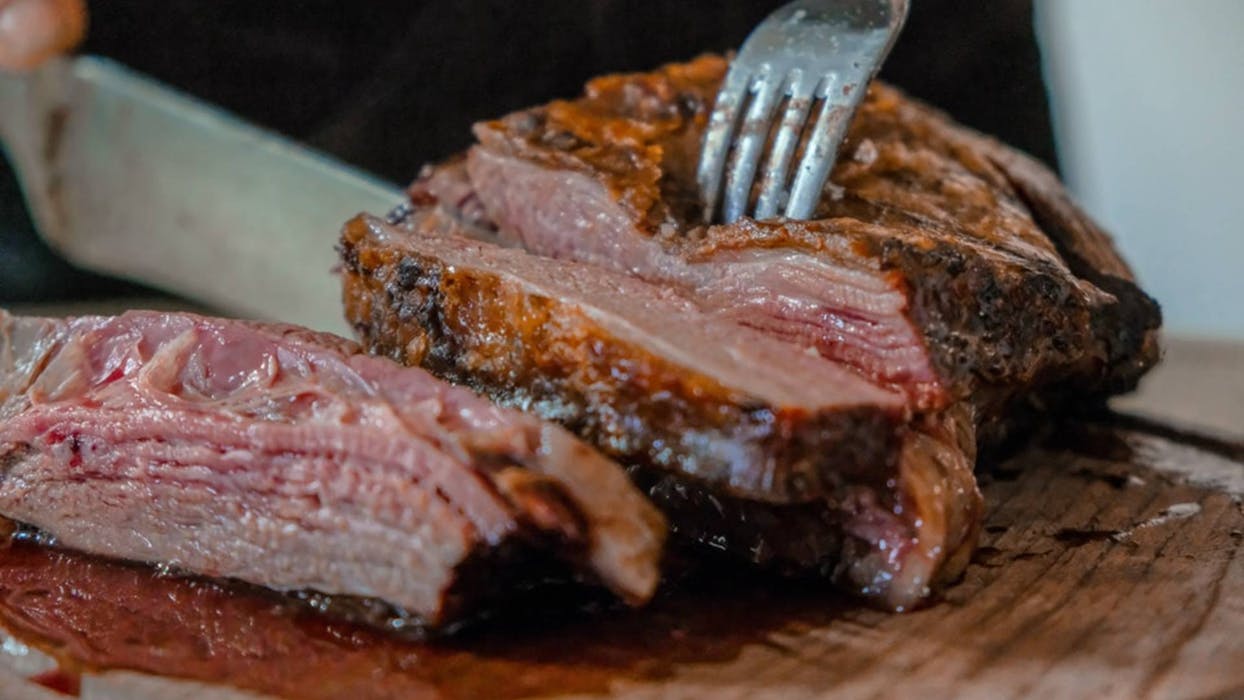How Fresh Meat Delivery Makes Eating Paleo Easy
What should humans eat? For most of human history, the answer to this question has been highly contextual: people ate the food that was readily available through agriculture, hunting, and trade.
 Back
Back






What should humans eat? For most of human history, the answer to this question has been highly contextual: people ate the food that was readily available through agriculture, hunting, and trade.

What should humans eat?
For most of human history, the answer to this question has been highly contextual: people ate the food that was readily available through agriculture, hunting, and trade. The stunningly diverse food cultures that evolved over time in all areas of the globe were a response to these restrictions.
But as trade networks and preserving techniques and technologies expanded, the dietary options grew alongside them. Even a hundred and fifty years ago, tropical fruits like oranges were quite rare outside of wealthy households, but thanks to industrial agriculture and global food systems, most North Americans can walk into their local supermarket and have their pick of ingredients and products from around the world, no matter the season.
This revolution in food has made that original question — what should humans eat? — all the more important. As the author Michael Pollan argued in his seminal book The Omnivore’s Dilemma, the diversity of food options that Canadians and Americans have has become its own kind of problem. After all, when the options for what you can eat are seemingly endless, the question of what you should eat becomes even more significant.
Perhaps it isn’t surprising, therefore, that so many of the diet trends of the past decade have been focussed on exploring how cutting back on certain foods or ingredients can help you eat in healthier and more sustainable ways. The paleo diet is just one exciting example of what a more disciplined, scientifically-informed approach to eating might look like.
So what is the paleo diet, and how does it work? The paleo diet is often compared to the keto diet, because both tend to emphasize meats and vegetables over carbohydrate-heavy foods like pasta and bread, and sometimes the terms are even used interchangeably. But there are significant differences between the paleo diet and other low-carb approaches, and understanding these differences it the key to understanding the unique appeal of going paleo.
Where the keto diet is based around taking advantage of a particular metabolic state known as ketosis, in which the body starts burning fat as its primary fuel, the paleo diet is designed to more closely mimic the kind of diet humans evolved to eat. This means that while paleo eaters tend not to consume a lot of carbohydrates, close monitoring of macronutrient intake that is such a key feature of the keto diet does not play much of a role when eating paleo.
Instead, paleo eaters focus on trying to recreate the kind of hunter-gatherer lifestyle that humans ate for millennia before the rise of agriculture. For this reason, the paleo diet goes heavy on foods like nuts and seeds, vegetables, fruits, fish, natural oils, and lean meats, and avoids cultivated foods like beans and legumes, grains, potatoes, refined sugars, dairy, and highly processed foods in general.
This means that people who adopt this diet often need to completely reimagine the kinds of meals they eat. Carbs, whether in the form or wheat, rice, or potatoes, form the base of most European, Indian, and East Asian cuisines, so making the jump to paleo requires a significant amount of discipline and planning.
This is where truLOCAL’s fresh meat delivery service comes in. Because we offer tons of options to choose from for people on the paleo diet, and because we work closely with local farms and producers that specialize in environmentally friendly farming methods, ordering meat through truLOCAL not only helps guarantee that you are getting the lean meats and fish you need to fuel your diet, but are also supporting responsible and sustainable agriculture.
While most of our meats are well suited to paleo eaters, here are four of our most popular paleo-friendly products.
For people who want to adopt a diet as close as possible to the one as early humans would have eaten, meat poses a bit of a problem. While hunter gatherers relied on animals for significant portion of their diet (according to one National Geographic article, as much as thirty percent of a hunter-gatherer’s annual calories come from meat and fish), that meat would largely come from game rather than livestock, as is still the case in regions with active hunter-gatherer populations.
Hunting is still a pretty popular pastime in Canada, but for those who weren’t raised with hunting as part of their culture, or who live in cities and don’t have access to the vehicles and equipment needed to undertake regular hunting trips, finding game can be quite difficult. Go into the meat section in your average grocery store, and you’re going to have a very hard time finding any game at all.
One of the things paleo eaters can do, however, is eating meat from livestock that has been raised in more natural conditions, like grass fed beef and free range chickens. The diet an animal eats plays a major role in shaping the composition of the meat that animal will produce, and a typical feedlot cow’s feed is light years away from the diet its wild ancestors would have eaten when they were first domesticated more than ten thousand years ago.
While we’ll probably never know what the first oxen to be tamed tasted like, once you taste the difference with grass fed beef you’ll have a sense for just how profound an impact diet has on flavour. Grass fed beef is much darker in colour and significantly leaner than grain-finished beef, and it has a much earthier, gamier flavour.
For many people, this game-like quality is desirable from a culinary point of view — fans of grass fed beef rave about its heavier, more substantial taste compared to the sweeter taste of grain-finished beef.
But for people following the paleo diet, grass fed beef is also desirable for other reasons. Wild animals typically don’t eat much grain at all, so grass fed beef is a great way to get back to an older way of raising meat without having to source wild game. And not only is grass fed beef significantly leaner than grain-finished alternatives, it also contains fifty percent more omega-3 fatty acids as well as higher in beneficial fats like conjugated linoleic acid.
Grass fed beef can still be difficult to find in some grocery stores, however, and when it is available it isn’t always local, which is why we offer online premium meat delivery that puts all your favourite cuts of grass fed beef at your fingertips. Whether you are looking for grass fed steaks, grass fed ground beef, or grass fed bone broth, signing up for truLOCAL’s fresh meat delivery service is a great way to ensure your favourite cuts of grass fed beef are always on hand.
Most people who adopt the paleo diet do so because they are concerned about the alarming number of chemical additives that are working their way into our diet, and want to go back to a simpler and more natural way of eating.
And while getting free range meat and eggs is one way to ensure that your meat has only seen minimal processing between the farm and the table, it can be more difficult when it comes to fish. The vast majority of Atlantic salmon sold in grocery stores today prefer to be from sources with the lowest prices, not the highest quality.
Making sure that the fish you eat is sourced from fisheries committed to sustainability and lack of chemicals is one of the most important steps you should take if your passion for healthy eating has led you to embrace the paleo diet.
When you order seafood through truLOCAL, you have plenty of high quality options from both wild-caught to sustainably raised sources. From sockeye salmon, cod, pickerel, haddock, and snapper to wild-caught shrimp and scallops, our meat boxes are perfectly designed for conscious eaters who love fish and want to make sure it remains sustainable for generations to come.
If you move in foodie circles, there is a good chance you’ve already come across bone broth. Bone broth has been an essential component in cuisines from around the world since before recorded history, but it has been experiencing a massive resurgence over the past ten years or so, as interest in more artisanal approaches to cooking has grown.
But bone broth has an ancient history, one that grew out of our hunter-gatherer ancestor’s desire to get as much nutrition as possible out of the animals they hunted. Unsurprisingly, bone broth has become particularly popular as a reliable soup base or a quick, drinkable snack for paleo eaters who don’t want to use heavily processed bouillon or heavily processed, pre-packaged broth or stock.
And if you are interested in making grass fed beef bone broth for yourself, your next truLOCAL order might be the logical place to start. Depending on what province you are ordering from, the options may be slightly different, but in most parts of Canada you can order bones, grass-fed stewing beef, or even pre-packaged bone broth itself.
Because we work with suppliers who take food seriously, we can guarantee that when you buy bone broth through truLOCAL, you’re getting a product that has been artisanally prepared, with the greatest care taken to preserve nutrients and flavour for an authentic eating experience.
If you’ve always wanted to try bone broth but are wary of purchasing from large brands that have opaque production methods, why not try bone broth from one of truLOCAL’s partners, or order some bones with your next meat box and follow one of the many paleo-friendly bone broth recipes available online.
Chicken may not inspire the kind of cultural love that steak and bacon get, but chicken and poultry remain the most popular meats in North America by a significant margin. It’s not hard to see why: chicken is lean, flavourful, and tends to be inexpensive. It is also a versatile staple of cuisines the world over.
But there are particular reasons why paleo eaters should pay attention to chicken: free run chickens are a great source of the kinds of light, healthy proteins that humans evolved to eat. Any simple diet in the hunter-gatherer style should include a healthy dose of unprocessed chicken.
When you shop for your meat through truLOCAL, you have plenty of opportunities to select the poultry cuts you love so you can make sure your freezer is never empty. Whether you want specific chicken products like drumsticks, wings, or sausage, or you want to go a whole foods route and order a whole chicken, with truLOCAL you can build your order around the meats you love.
And when you shop using our subscription service, you can make sure that your meat box arrives every two weeks, every three weeks, or monthly. We deliver straight to your house, apartment, gym, or workplace, and because we pack our meat in dry ice, your order will keep cold all day — which means you don’t have to worry about being home to receive it.
For tens of thousands of years, humans roamed the world hunting, fishing, and living off of the bounty of the land. Fortunately, it is no longer necessary to spend all day waiting for a fish to come along; twenty-first century paleo eaters can experience all the benefits that come from the paleo diet while also benefiting from the advantages of living in a post-industrial world.
If you want to make going paleo even more seamless, sign up for fresh meat delivery from truLOCAL, and find out just how easy eating well can be!
Posted on February 9th, 2024